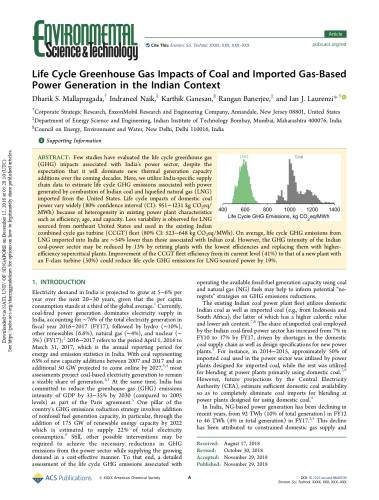Paper
Life Cycle Greenhouse Gas Impacts of Coal and Imported Gas-Based Power Generation in the Indian Context
Dharik S. Mallapragada, Indraneel Naik, Karthik Ganesan, Rangan Banerjee, and Ian J. Laurenzi
November 2018 |
Suggested citation: Mallapragada, Dharik S., Indraneel Naik, Karthik Ganesan, Rangan Banerjee, and Ian J. Laurenzi. 2018. "Life Cycle Greenhouse Gas Impacts of Coal and Imported Gas-Based Power Generation in the Indian Context." Environmental science & technology 53, no. 1: 539-549.
Overview
This paper utilises India-specific supply chain data to estimate life cycle greenhouse gas (GHG) emissions of indigenous coal-based power generation in India relative to imported fossil fuels, namely, liquefied natural gas (LNG) from the United States. It lays a particular emphasis on quantifying the variability in GHG impacts among individual power plants in the coal and natural gas power fleets. The analysis is based on various sources, including annual power plant emissions data for representative subsets of existing coal and gas power plants in India in recent years (FY12−FY15), data associated with mining and transportation of domestic coal in India using a combination of country-specific data sources, fuel consumption data for the Indian gas pipeline network, and Indian power plant characteristics synonymous with the lowest and highest life cycle GHG emissions. It aims to inform national policy on possible “no-regrets” GHG emissions reduction strategies as well as trade-offs between costs and emissions.
Key Highlights
- The average life cycle GHG emissions of domestic coal-based power is estimated to decline by 3 per cent from FY12 to FY15, partly because of the increasing share of generation from recently commissioned, efficient (mostly supercritical) power plants.
- Concurrently, the share of electricity generated from coal has increased by 36 per cent from FY12 to FY15. The pace of decline in emissions intensity is more than offset by the growth in generation.
- When sorted on a life cycle GHG emissions basis, the top quintile of power plants with mean life cycle GHG emissions < 1020 kg CO2eq/MWh are on average estimated to be nine years younger, virtually four times in size, and witness 50 per cent greater utilisation, compared to the bottom quintile of plants with mean life cycle GHG emissions >1262 kg CO2eq/MWh.
- In the short term, there is a potential opportunity to further reduce fleet-average life cycle GHG emissions by shifting generation from the bottom quintile to the top quintile of coal power plants with spare capacity, subject to operational constraints.
- Longer-term substantial GHG emissions reductions in the power sector may be achieved by displacing coal-based power with LNG-based power, which is estimated to be associated with 54 per cent lower life cycle GHG emissions compared to Indian (domestic) coal-based power generation.
- A brief comparison of life cycle GHG impacts for LNG sourced from alternative regions suggests that the variability in GHG emissions between different LNG sources tends to be smaller than the differences in GHG emissions between LNG and coal-based power generation.
On average, life cycle GHG emissions from LNG imported into India are ∼54 per cent lower than those associated with Indian coal. The GHG intensity of the Indian coal-power sector may be reduced by 13 per cent by retiring plants with the lowest efficiencies and replacing them with higher efficiency supercritical plants.





